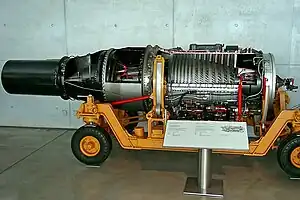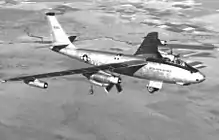Wright J65
The Wright J65 was an axial-flow turbojet engine produced by Curtiss-Wright under license from Armstrong Siddeley. A development of the Sapphire, the J65 powered a number of US designs.
| J65 | |
|---|---|
 | |
| A sectioned Wright J65 | |
| Type | Turbojet |
| National origin | United States |
| Manufacturer | Curtiss-Wright |
| First run | March 1951 (J65)[1] |
| Major applications | |
| Developed from | Armstrong Siddeley Sapphire |
Design and development
Curtiss-Wright purchased a license for the Sapphire in 1950, with plans to have the production lines running in 1951. However a series of delays due to design changes by Curtiss-Wright, such as substituting the Sapphire's machined midsection solid forged diffuser frame with a fabricated one of welded nodular iron,[2] led to its service introduction slipping two years. The fabricated assembly, a more practicable production job with about one fifth the cost, was subsequently adopted for the Sapphire.[3]
Another change addressed the Sapphire's only major problem. The Sapphire was found to work well through the entire RPM range without the compressor stalling, which allowed it to dispense with inlet guide vanes or other solutions found on contemporary designs. However, in service it was found that while pressure was maintained even at low speeds and RPM, the first stages were stalling and this was causing significant vibration and fatigue issues. Wright solved this by adding inlet ramps that closed off the outer portions of the intake at low RPM. Armstrong Siddeley evaluated this for the UK Sapphires, but adopted a different solution instead.[1][4]
By service introduction, the Pratt & Whitney J57 was on the market and took many of the J65's potential sales. Nevertheless, along with the Martin B-57 Canberra, its original application, the J65 went on to power versions of the North American FJ Fury, Douglas A-4 Skyhawk, Republic F-84F Thunderstreak, and the two Lockheed XF-104 Starfighter prototypes. Problems Grumman had with the engine in the F11F Tiger, particularly below-spec afterburning thrust, caused them to specify the General Electric J79 for the Grumman F11F-1F Super Tiger.[5]
Wright T49

A 6,500–10,380 shp (4,850–7,740 kW) turboprop version of the J65 (Sapphire) was developed by Curtiss-Wright as the Wright T49, and a commercial derivative, the Wright TP51A2 was also designed. The T49 first ran in December 1952 at 8,000 shp (6,000 kW), followed by flight testing in a Boeing XB-47D test bed from 26 August 1955. By this time however, the market for the engine had vanished.[6]
Variants
- J65-W-1
- 7,200 lbf (32,000 N)
- J65-W-2
- United States Navy (USN) variant similar to -1 producing 7,220 lbf (32,100 N) of thrust.
- J65-W-3
- 7,700 lbf (34,000 N)
- J65-B-3
- Production by Buick Motor Division of General Motors Corporation, similar to -1.
- J65-W-4
- 7,700 lbf (34,000 N)
- J65-W-4B
- 7,650 lbf (34,000 N)
- J65-W-5
- J65-W-6
- J65-W-7
- 7,700 lbf (34,000 N)
- J65-W-11
- J65-W-12
- J65-W-16
- J65-W-16A
- 7,700 lbf (34,000 N)
- J65-W-16C
- 8,500 lbf (38,000 N)
- J65-W-18
- 10,500 lbf (47,000 N) -16A with reheat
Applications
- J65
- Douglas A-4 Skyhawk
- Grumman F-11 Tiger
- Martin B-57 Canberra
- Lockheed XF-104
- North American FJ-3 Fury
- North American FJ-4 Fury
- Republic F-84F Thunderstreak
- T49
- Boeing XB-47D (T49 testbed)
Specifications (J65-B)
General characteristics
- Type: turbojet
- Length: ~122 in (3,100 mm)
- Diameter: 37.52 in (953 mm)
- Dry weight: 2,776 lb (1,259 kg)
Performance
- Maximum thrust: 7,239 lbf (32.20 kN)
- Overall pressure ratio: 7:1
- Air mass flow: 119.05 lb/s (54.00 kg/s)
- Turbine inlet temperature: ~848 °C (1,560 °F)
- Specific fuel consumption: ~0.916 lb/(lbf⋅h) (25.9 g/(kN⋅s))
- Thrust-to-weight ratio: 2.61
See also
Related development
Comparable engines
Related lists
References
- "Armstrong Siddeley Sapphire". Flight: 22. 6 January 1956.
- "World Encyclopedia of Aero Engines - 5th edition" by Bill Gunston, Sutton Publishing, 2006, p.249
- "Armstrong Siddeley Sapphire". Flight: 20. 6 January 1956.
- Filippi, Richard E.; Lucas, James G. (April 5, 1955). "Effect of Compressor-inlet Area Blockage on Performance of an Experimental Compressor and a Hypothetical Engine" (PDF). Lewis Flight Propulsion Laboratory, Cleveland, Ohio: NACA. RM E54LOl.
- "Grumman's Mach-2 International F11F-1F Supertiger" Corwin Meyer, Naval Fighters Number Forty-Four, Steve Ginter 1998, ISBN 0-942612-44-2, p.1
- "World Encyclopedia of Aero Engines - 5th edition" by Bill Gunston, Sutton Publishing, 2006, p.249
External links
- A 1952 advert for the Sapphire/J 65
- "Anglo-American Jewel - Engineering Details of the Wright J65 Sapphire Revealed" - a 1954 Flight article on the J65